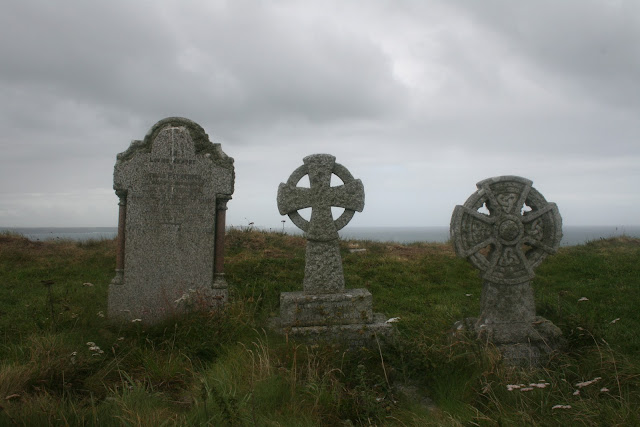If any of you ever come out to the UK, I have three words for you: Survey Ordnance Map. The lovely lady that runs the hostel here lent me one today. It is filled with words like "standing stone," "tumulus," "cairn," "hut circle," all sorts of archaeological sites. This map led me along public footpaths through farms and woods to the Madron "baptistry," which dates to the 6th century AD, and the Madron wishing well, a sacred site. A couple miles further up I reached a stone circle, the Nine Maidens, and saw numerous burial cairns on the way. Magical today, and soaking wet as well.
The above and below are a Celtic "chapel" or "baptismal font." (From what I understand, it's a pagan shrine of some sort). It dates to the 6th century AD. The photo below shows where a spring has been diverted into a small gap in the wall (you can't see it in the shot) which then trickles into a small pool, where the black area is.
The footpath up to Nine Maidens from the Maden Celtic ruins and wishing well. The paths go along walls that separate farming plots, and this one in particular went straight through a wheat field. I noticed that someone had left some grains of wheat tied together and placed in a couple spots at the ruins. I took off a head of wheat for myself as I walked through. When I got back to the hostel, an Italian girl, one of my bunkmates, told me to keep it as an amulet.
3 of the stones at Nine Maidens. I'm hugging one of them.
This one still retains much of its shape - you can see how careful they were to dress the stones.
Another shot of the three most intact stones
You can just make out many of the stones in the circle. The little hill in the foreground is a burial cairn.
I don't know if this photo shows it well, but it appears that the stones are slightly concave facing the interior of the circle. It tripped me out a bit. I told the lady at the hostel that I counted 11 stones, and there must have been more...so why "Nine" Maidens? She said the Victorians who "named" it only counted nine stones of significance, but that stone circles typically have nineteen stones. "Nineteen," I say, "That's the same number as the lunar cycle." "Yes," she said. "They think the lunar cycle may have something to do with all these stone circles." Cool.


















































